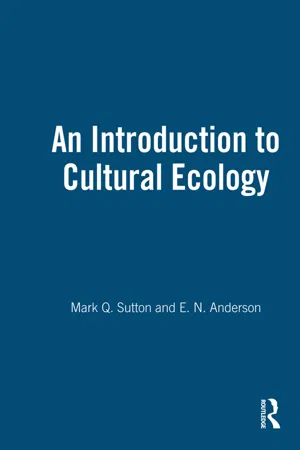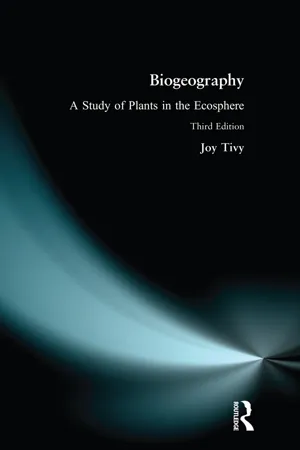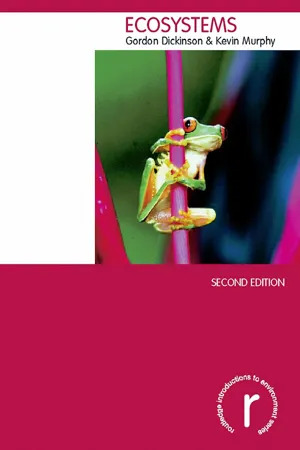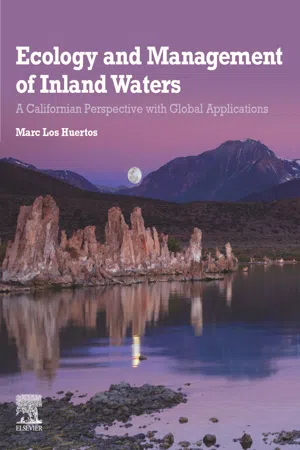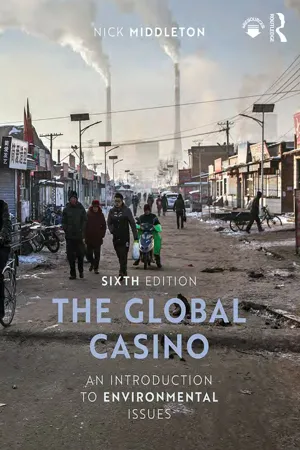Geography
Interaction between Environment and Biota
The interaction between environment and biota refers to the dynamic relationship between living organisms and their surrounding environment. This includes the ways in which biota, such as plants and animals, adapt to and modify their environment, as well as how the environment influences the distribution and behavior of biota. This interaction is a fundamental concept in understanding ecosystems and biodiversity.
Written by Perlego with AI-assistance
Related key terms
8 Key excerpts on "Interaction between Environment and Biota"
- eBook - ePub
- Mark Q. Sutton, E. N. Anderson(Authors)
- 2020(Publication Date)
- Routledge(Publisher)
2 Fundamentals of EcologyEcology is the study of the relationships between organisms and their environment; the “economics” (or livelihood) of the Earth and its totality of life forms. The term “ecology” comes from the Greek word oikos (house or habitat) and ology (the study of). It was given its contemporary usage by Ernst Haeckel in 1866 (see Goodland 1975). Most of the concepts used in human ecology have been borrowed from biology, so an understanding of the basic notions of biological ecology is essential (Richerson 1977). For more detailed treatment of ecological concepts, see Odum (1975, 1993), Kormondy (1996), or Molles (1999).THE ENVIRONMENTThe environment consists of the surroundings within which an organism interacts—a pretty broad definition. One of the problems in defining the environment is this breadth; the environment can be viewed as different things in different places and at different geographic or spatial levels, such as a pond, a valley, a continent, the Earth, the solar system, or even the universe. Perhaps the concept of the “operating environment,” that area in which the population under consideration operates, is more useful.The environment can be divided into two primary components, abiotic and biotic (see Kormondy 1996:6). The abiotic component consists of the inorganic materials present in the environment, including elements such as oxygen, nitrogen, sodium, and carbon and compounds such as water and carbon dioxide. The abiotic component also includes physical factors, such as weather, climate, geological materials, geography, time, solar radiation (the source of most energy), and even the cosmos.The biotic component consists of all of the materials that are biological in origin: plants, animals, and microbes, either living or dead. Thus, a living tree is part of the biotic environment, as is a dead, fallen, and decomposing tree. Eventually, the tree will be broken down into its inorganic constituents, and those materials will again enter the abiotic environment. - eBook - ePub
Biogeography
A Study of Plants in the Ecosphere
- Joy Tivy(Author)
- 2018(Publication Date)
- Routledge(Publisher)
The first is the intimate interrelationship between the organic and inorganic elements of the earth’s environment; the character of the biosphere is primarily a product of the continual interaction or interchange between the lithosphere and the atmosphere. The second is the reciprocal relationship between humans and the biosphere. On the one hand the latter provides the vital link between man and his physical environment; and despite the advances of modern science and technology man is still, whether he realises or likes it, completely dependent on the biosphere for his food. On the other hand, because of an ability, greater than that possessed by any other form of life, to exploit organic resources he is not only an integral part of the biosphere but is now the ecologically dominant organism in it. The significance of biogeography is particularly well expressed by the ecologist M.G. Lemée (1967: 4) in Précis de Biogégraphie, when he states: C’est [la biogégraphie] aussi une science géographique, car elle tend à établir les rapports avec des peuplements végétaux et animaux avec les autres grandes phénomènes géomorphologie, sols, activités humaines, pour atteindre â une vue synthétique des aspects de la surface du Globe. Pour le géographe la connaissance de la partie vivante du paysage intervient comme un élément de première importance de ce complex, car liée aux autres éléments par d’étroites relations mutuelles, elle constitue un indicateur très sensible des caractères du milieu géographique. However, the definition and, hence, the delimitation of the scope of biogeography varies dependent on whether or not the aim or point of view has been primarily biological or geographical and on the role accorded to man in the study of the biosphere. Until relatively recendy ecologists tended to regard humans as an important but ‘unnatural’ elements in the environment of plants and animals - eBook - ePub
- Gordon Dickinson, Kevin Murphy(Authors)
- 2007(Publication Date)
- Routledge(Publisher)
1 The nature of ecosystems
The biological world is one of great diversity and complexity. A systems approach is useful in helping us to understand the interactions between living organisms and their environment (which includes the biotic environment of other living creatures). The concept of the ecosystem provides a way in which the functioning of the biological world and its interactions with the physical environment can be understood. The ecosystem concept is useful in resource management and as a basis for predictive modelling. This chapter covers:- Complexity of the biological world and its physical environment
- Development of the ecosystem concept
- System theory, ecology and ecosystems
- Abiotic and biotic environment of ecosystems
How this book approaches the complexity of the biological world and its environment
How can we make sense of the complex and constantly changing interactions between the living world, with its myriad species and individuals, and the multifaceted and dynamic environment which life inhabits? In this book we examine this basic question, starting from the idea of the ecosystem as the basic unit of living organisms in the environment. Understanding how ecosystems operate, and how they support the existence of groups of organisms, is not just a question of scientific interest. At a gathering pace since the 1940s, there has been increasing concern about harmful effects caused by human actions on the planet’s life support system. Although concerns were, at first, confined to a small group of scientists and environmental activists, it is now a global issue at the top of the international political agenda. Exactly what has occurred and what may happen in the future is not clear. However, most informed people agree that at best the consequences may be uncomfortable for humankind, and at worst may be catastrophic.The ecosystem concept is fundamental to examination of human impacts on life on Earth. It provides a way of looking at the functional interactions between life and environment which helps us to understand the behaviour of ecological systems, and predict their response to human or natural environmental changes. - eBook - ePub
- Azhar ul Haque Sario, Azhar ul Haque Sario(Authors)
- 2023(Publication Date)
- tredition(Publisher)
Imagine an ecosystem as a vast, interconnected web. At its heart are the communities of organisms - a diverse cast of characters, ranging from tiny insects to towering trees, from nimble fish to majestic birds. Each of these organisms has a role to play, a part in the grand narrative of life.Surrounding these organisms is their environment - the stage upon which they perform. This includes the soil, water, air, and all the physical conditions that set the scene for life's drama. The environment is more than just a backdrop; it's an active participant in the life of the ecosystem. It provides the essentials - light, heat, nutrients, and space.Now, imagine the interactions within this ecosystem. These interactions are like the dialogues and actions in a play, defining the relationships and dependencies among the organisms and their environment. Plants use sunlight and soil nutrients to grow, providing food and shelter for animals. Animals, in return, help plants by pollinating flowers or spreading seeds.Even the elements play a role. Rain nourishes the soil, rivers shape the landscape, and winds spread pollen and seeds. These non-living components, though silent, are vital actors in the ecosystem's play.In an ecosystem, everything is connected. A change in one element can send ripples throughout the system. If a species disappears, or if the climate changes, it can alter the balance of the whole ecosystem. This delicate equilibrium is what makes ecosystems so fascinating and so vital.In summary, an ecosystem is a living, breathing community of organisms and their environment, all intricately linked and constantly interacting. It's a dynamic and complex world, where each element, whether a leaf or a lake, a butterfly or a breeze, contributes to the tapestry of life.Biodiversity is like a vast collection of different notes in a grand musical symphony. Each note represents a unique species living in a particular area. Just as a symphony is more enchanting with a variety of notes, an area becomes more lively and fascinating with a diversity of plants, animals, and other living beings.Think of a melody. If the melody has only one note, it may still sound pleasant, but it lacks depth and variation. Now imagine this melody enriched with numerous notes, high and low, creating a harmonious and captivating tune. This melody, with its diversity, is not only more melodious; it’s more vibrant and full of life. - eBook - ePub
Ecology and Management of Inland Waters
A Californian Perspective with Global Applications
- Marc Los Huertos(Author)
- 2020(Publication Date)
- Elsevier(Publisher)
Whereas competition may influence population dynamics, exclude weaker competitors, and promote niche differentiation, we also recognize that numerous other types of species interactions occur in streams, lakes, wetlands, etc. Predation, cannibalism, disease, and parasitism are commonly observed factors that affect population dynamics.After reading this chapter, you should be able to- 1. Use predator–prey equations to evaluate the role of trophic interactions to predict population dynamics;
- 2. Summarize how sexual selection can influence population dynamics, e.g., predator/prey and infection vector and host;
- 3. Describe succession and how communities change with time;
- 4. Evaluate various lotic and lentic systems using energy transfer and nutrient flux in ecosystems.
Environment: Biotic Factors
Types of Species Interactions
Whereas the common use of the word “environment” refers to everything around us, ecologists identify two broad environmental factors: 1) abiotic factors: the physical and chemical factors, and 2) biotic factors: interacting organisms. When evaluating an area, we analyze a combination of abiotic and biotic factors to better understand the patterns and processes in ecological systems. The biotic factors include numerous types of interactions, including competition, discussed in Chapter 4 . Although inter- and intraspecific competition may play an important role in population growth, other asymmetric interactions also structure communities in visible and dramatic ways (Table 5.1 ).Table 5.1 Type of asymmetric interactions between two species.Interaction Effect of Sp. 1 on Sp. 2 Effect of Sp. 2 on Sp. 1 Exploitation Positive Negative Competition Negative Negative Mutualism Positive Positive Commensalism None Positive Amensalism None Negative Nuetralism None None Extending Population Biology
Primary Production and Herbivory
Periphyton is a combination of algae and bacteria that grow on stream bottom substrates. The growth of the algae is not only controlled by the competition for light and nutrients, but also by herbivory. Herbivory is a type of exploitation as it reduces algae (or plant) biomass, but have other effects too, e.g., increasing the diversity of the algae species, increasing productivity by reducing self-shading, and stimulating growth by releasing nutrients. But these changes can also depend on the herbivore species. - eBook - ePub
- Cynthia Metcalf, Rhonda Atkinson(Authors)
- 2017(Publication Date)
- Research & Education Association(Publisher)
The study of culture and Earth interactions is called cultural ecology. Political ecology is a multi-disciplinary study of how social and environmental change occurs in the context of power relations, social structures, economic issues, and human–environment interactions. Humans depend on the environment to provide them with their basic needs: food, shelter, and clothing. Humans also modify that same environment in order to meet their needs. For instance, people build dams to change the way water flows, plow and irrigate fields to grow food, clear forests to build houses, and dig mines for minerals and natural resources that help sustain life. Humans adapt to their environment if they cannot change it. For instance, people put on warm coats and use heaters when they live in cold climates. How people adapt to their environment depends to a large extent on their ability to do so—and it reflects their economic and political circumstances and their technological abilities. Human–environment interaction has also shaped Earth’s physical systems and features. For example, building on oceanfronts may increase erosion and alter the landscape. Clearing forests to make room for agriculture or cities changes the appearance of the landscape. Building dams and canals changes the way water flows. Geographers approach the study of human–environment interaction in a variety of ways: Environmental determinism: This is the view that the environment can overpower people and determine their culture and the direction and extent of their development. This is widely considered a “not politically correct” belief in geography. The main train of thought in environmental determinism is that an area’s physical characteristics, like climate, impact how people develop over time - eBook - ePub
The Global Casino
An Introduction to Environmental Issues
- Nick Middleton(Author)
- 2018(Publication Date)
- Routledge(Publisher)
CHAPTER 1 The physical environmentLearning Outcomes At the end of this chapter you should:- Appreciate some of the key ways we classify the natural world by identifying units, such as biomes.
- Understand how the natural world works through the recognition of cycles, such as the hydrological cycle.
- Appreciate the importance of scale (both time and space).
- Recognize that the state of our knowledge of the natural world is imperfect.
- Understand that our sources of data include direct and indirect methods of measurement.
- Appreciate that a scientific approach to environmental change is dominant but it is by no means the only kind of knowledge about how our planet works.
Key Conceptsproductivity, biome, food chain, biogeochemical cycle, regime shift, feedback, threshold, timelag, resistance, resilience, equilibrium, linear/non-linear system, proxy methods, palaeoenvironmental indicatorThe term environment is used in many ways. This book is about issues that arise from the physical environment, which is made up of the living (biotic) and non-living (abiotic) things and conditions that characterize the world around us. While this is the central theme, the main reason for the topicality of the issues covered here is the way in which people interact with the physical environment. Hence, it is pertinent also to refer to the social, economic and political environments to describe those human conditions characteristic of certain places at particular times, and to explain why conflict has arisen between human activity and the natural world. This chapter looks at some of the basic features of the physical environment, while Chapter 2 is concerned with the human factors that affect the ways in which the human race interacts with the physical world.Classifying the Natural World
Geography, like other academic disciplines, classifies things in its attempt to understand how they work. The physical environment can be classified in numerous ways, but one of the most commonly used classifications is that which breaks it down into four interrelated spheres: the lithosphere, the atmosphere, the biosphere and the hydrosphere. These four basic elements of the natural world can be further subdivided. The lithosphere, for example, is made up of rocks that are typically classified according to their modes of formation (igneous, metamorphic and sedimentary); these rock types are further subdivided according to the processes that formed them and other factors such as their chemical composition. Similarly, the workings of the atmosphere are manifested at the Earth’s surface by a typical distribution of climates; the biosphere is made up of many types of flora and fauna; and the hydrosphere can be subdivided according to its chemical constituents (fresh water and saline, for example), or the condition or phase of the water: solid ice, liquid water or gaseous vapour. - eBook - ePub
Plant Invasions
The Role of Biotic Interactions
- Anna Traveset, David M. Richardson, Anna Traveset, David M Richardson(Authors)
- 2020(Publication Date)
- CAB International(Publisher)
Changes in biotic interactions in the native and invaded range can enable a non-native species to establish and spread in novel environments. Invasive non-native species can in turn generate impacts in recipient systems partly through the changes they impose on biotic interactions; these interactions can lead to altered ecosystem processes in the recipient systems. This chapter reviews models, theories and hypotheses on how invasion performance and impact of introduced species in recipient ecosystems can be conjectured according to biotic interactions between native and non-native species. It starts by exploring the nature of biotic interactions as ensembles of ecological and evolutionary games between individuals of both the same and different groups. This allows us to categorize biotic interactions as direct and indirect (i.e. those involving more than two species) that emerge from both coevolution and ecological fitting during community assembly and invasion. We then introduce conceptual models that can reveal the ecological and evolutionary dynamics between interacting non-native and resident species in ecological networks and communities. Moving from such theoretical grounding, we review 20 hypotheses that have been proposed in invasion ecology to explain the invasion performance of a single nonnative species, and seven hypotheses relating to the creation and function of assemblages of non-native species within recipient ecosystems. We argue that, although biotic interactions are ubiquitous and quintessential to the assessment of invasion performance, they are nonetheless difficult to detect and measure due to strength dependency on sampling scales and population densities, as well as the non-equilibrium transient dynamics of ecological communities and networks. We therefore call for coordinated efforts in invasion science and beyond, to devise and review approaches that can rapidly map out the entire web of dynamic interactions in a recipient ecosystem.2.1 The Nature of Biotic InteractionsBiotic interactions are ubiquitous and quintessential for the survival of any species, and this is certainly true for non-native plant species in a novel environment (Richardson et al.,
Learn about this page
Index pages curate the most relevant extracts from our library of academic textbooks. They’ve been created using an in-house natural language model (NLM), each adding context and meaning to key research topics.
